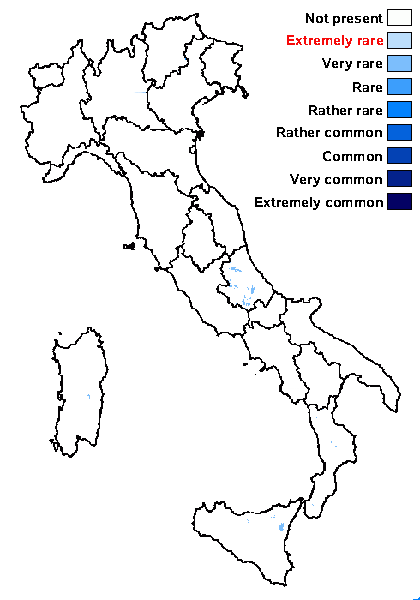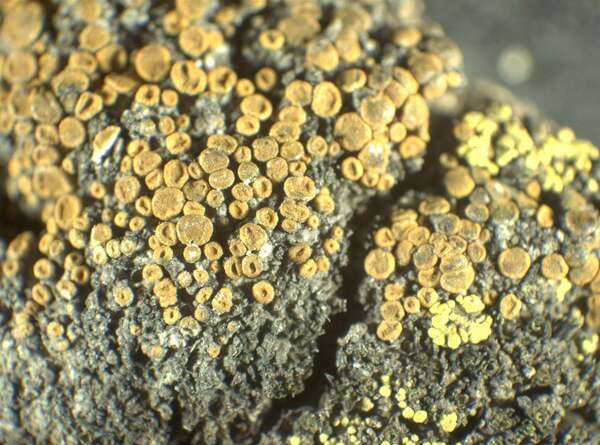Parvoplaca chelyae (Pérez-Vargas) Vondrák, Halici & Arup
in Arup & al., Lichenologist, 47: 384, 2015. Basionym: Caloplaca chelyae Pérez-Vargas in Pérez-Vargas & Pérez de Paz - Bryologist, 112: 840, 2009.
Synonyms: Caloplaca fulvolutea auct. ital. p.p.
Distribution: C - Abr (Nimis & Tretiach 1999), Sar. S - Cal (Puntillo 1996), Si (TSB 12426).
Description: Thallus crustose, very thin and sometimes poorly evident, usually continuous, pale grey. Apothecia biatorine, 0.5-1 mm across, usually abundant and often crowded, rounded, adnate to sessile and constricted at base, with a concave to flat, epruinose, yellow-orange disc (sometimes finally orange-brown to blackish brown) and a slightly paler, entire, smooth proper margin. Proper exciple prosoplectenchymatous, 80-100 µm wide laterally, thinner at base; epithecium brownish orange, K+ purple-red; hymenium colourless, 70-90(-100) µm high, not inspersed with oil droplets: paraphyses simple or sparingly branched, 2-3 µm thick at mid-level, the apical cells swollen, 5-7 µm wide; hypothecium colourless. Asci 8-spored, clavate, functionally unitunicate, apically thickened with a broad internal beak, the inner part of apex and external cap I+ blue, Teloschistes-type. Ascospores 2-celled, polarilocular, hyaline, ellipsoid, (12-)13-15 x (7-)8-11 µm, the equatorial thickening (“septum”) (2.5-)3-5 µm. Photobiont chlorococcoid. Spot tests: thallus K-, C-, KC-, P-; apothecia K+ purple-red, C-. Chemistry: thallus without lichen substance; apothecia with parietin (major), fallacinal, emodin, teloschistin and parietinic acid (minor), corresponding with chemosyndrome A of Søchting (1997); blackened parts of apothecia with the Cinereorufa-green pigment. Note: this species was described recently from the Canary Islands, where it grows on bryophytes in the dry alpine zone, and is also known from Turkey. It is probably strictly muscicolous on siliceous bedrocks in dry alpine or dry continental sites, and was treated under Caloplaca fulvolutea by most Italian authors.
Growth form: Crustose
Substrata: soil, terricolous mosses, and plant debris
Photobiont: green algae other than Trentepohlia
Reproductive strategy: mainly sexual
Commonnes-rarity: (info)
Alpine belt: very rare
Subalpine belt: very rare
Oromediterranean belt: very rare
Montane belt: absent
Submediterranean belt: absent
Padanian area: absent
Humid submediterranean belt: absent
Humid mediterranean belt: absent
Dry mediterranean belt: absent

Predictive model
Herbarium samples
Growth form: Crustose
Substrata: soil, terricolous mosses, and plant debris
Photobiont: green algae other than Trentepohlia
Reproductive strategy: mainly sexual
Commonnes-rarity: (info)
Alpine belt: very rare
Subalpine belt: very rare
Oromediterranean belt: very rare
Montane belt: absent
Submediterranean belt: absent
Padanian area: absent
Humid submediterranean belt: absent
Humid mediterranean belt: absent
Dry mediterranean belt: absent

Predictive model
| Herbarium samples |
 INDEX FUNGORUM
INDEX FUNGORUM
 GBIF
GBIF



